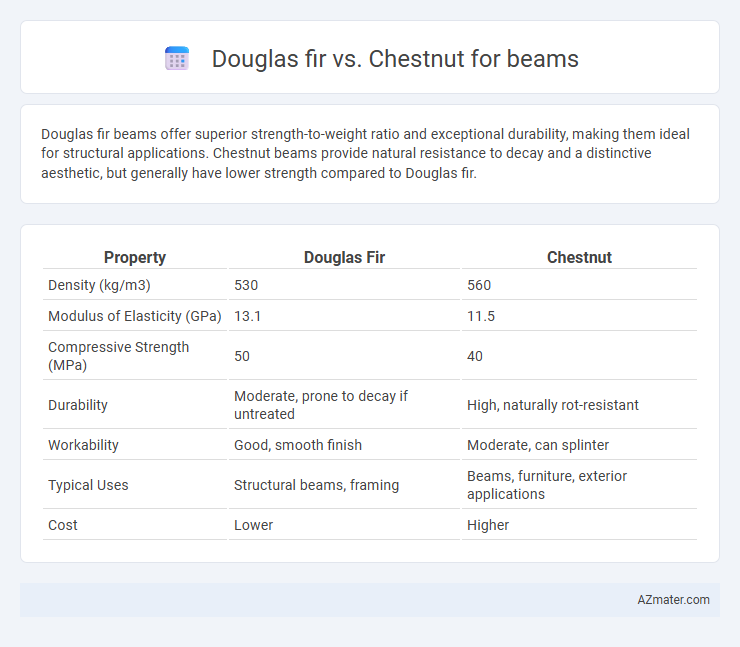Douglas fir beams offer superior strength-to-weight ratio and exceptional durability, making them ideal for structural applications. Chestnut beams provide natural resistance to decay and a distinctive aesthetic, but generally have lower strength compared to Douglas fir.
Table of Comparison
| Property | Douglas Fir | Chestnut |
|---|---|---|
| Density (kg/m3) | 530 | 560 |
| Modulus of Elasticity (GPa) | 13.1 | 11.5 |
| Compressive Strength (MPa) | 50 | 40 |
| Durability | Moderate, prone to decay if untreated | High, naturally rot-resistant |
| Workability | Good, smooth finish | Moderate, can splinter |
| Typical Uses | Structural beams, framing | Beams, furniture, exterior applications |
| Cost | Lower | Higher |
Introduction to Douglas Fir and Chestnut as Beam Materials
Douglas fir is renowned for its exceptional strength-to-weight ratio and dimensional stability, making it a preferred beam material in construction. Chestnut offers a durable, rot-resistant alternative with a distinctive grain pattern, valued for both structural integrity and aesthetic appeal. Both species provide reliable load-bearing capacity, but Douglas fir's widespread availability and consistent quality make it a dominant choice for heavy timber beams.
Physical Properties: Douglas Fir vs Chestnut
Douglas fir exhibits a higher density, averaging around 530 kg/m3, offering superior strength and stiffness compared to chestnut, which has a lower density near 480 kg/m3. Douglas fir's modulus of elasticity ranges between 12,000 to 15,000 MPa, giving it excellent load-bearing capacity ideal for structural beams, whereas chestnut has a modulus closer to 10,000 MPa. Moisture resistance is better in chestnut due to its natural tannins, making it more durable in outdoor or humid conditions, while Douglas fir requires treatment to prevent decay.
Strength and Durability Comparison
Douglas fir beams demonstrate superior strength with a modulus of rupture averaging 12,600 psi, making them ideal for heavy load-bearing applications compared to chestnut, which averages around 9,100 psi. In terms of durability, Douglas fir offers moderate natural resistance to decay but requires treatment for prolonged outdoor use, whereas chestnut exhibits exceptional rot resistance and longevity in exterior environments due to its high tannin content. Choosing Douglas fir ensures greater structural capacity, while chestnut provides better natural durability, especially in moisture-prone conditions.
Workability and Handling Differences
Douglas fir beams offer excellent workability due to their fine, uniform texture and straight grain, making them easier to cut, shape, and fasten with standard woodworking tools. Chestnut beams are denser and harder, resulting in a more challenging handling process that may require sharper tools and greater effort during machining and fastening. While Douglas fir provides smoother handling for precision work, chestnut's toughness offers enhanced durability but demands increased labor for shaping and finishing.
Resistance to Decay and Insects
Douglas fir exhibits moderate resistance to decay and insect attacks, making it suitable for interior beams where exposure to moisture is limited. Chestnut offers superior natural resistance to decay and insects due to its high tannin content, enhancing durability in outdoor or high-humidity environments. Choosing chestnut beams ensures greater longevity and reduced maintenance in applications prone to fungal or insect damage.
Cost and Availability
Douglas fir beams offer a favorable balance of cost-efficiency and widespread availability, making them a popular choice in construction and woodworking projects. Chestnut beams, while valued for their durability and aesthetic appeal, generally come at a higher price point due to limited supply and the scarcity of mature trees suitable for timber. For budget-conscious projects requiring structural reliability, Douglas fir provides a more accessible and economically viable option compared to the premium cost and seasonal availability constraints associated with chestnut.
Aesthetic Qualities and Grain Patterns
Douglas fir beams exhibit a warm reddish-brown hue with a distinct straight grain pattern, creating a clean, modern aesthetic ideal for contemporary architectural designs. Chestnut beams showcase a rich golden-brown color combined with an intricate, swirling grain pattern that adds rustic charm and visual complexity to traditional or farmhouse-style interiors. The tight, uniform grain of Douglas fir offers a sleek appearance, while the prominent grain variations in chestnut emphasize natural character and texture in beam applications.
Sustainability and Environmental Impact
Douglas fir beams offer a sustainable choice due to their fast growth rate and high yield, contributing to responsible forest management and carbon sequestration. Chestnut beams, often sourced from reclaimed or naturally harvested trees, provide environmental benefits by reducing the need for new logging and preserving biodiversity. Both wood types boast strong durability, but Douglas fir's widespread availability typically results in a lower overall environmental footprint compared to sustainably harvested chestnut.
Best Applications for Each Wood Type
Douglas fir excels in structural applications requiring high strength-to-weight ratio and durability, making it ideal for heavy beams in residential and commercial construction. Chestnut is preferred for decorative beams and restoration projects due to its attractive grain, natural rot resistance, and historical authenticity in older buildings. For load-bearing purposes, Douglas fir outperforms chestnut, while chestnut is favored for aesthetic appeal and longevity in exposed timber elements.
Conclusion: Choosing the Right Wood for Your Beams
Douglas fir offers exceptional strength, durability, and a straight grain that makes it ideal for heavy-duty beams requiring high load-bearing capacity. Chestnut, prized for its natural resistance to decay and distinctive grain, suits rustic designs but may lack the strength needed for structural beams in demanding applications. Selecting the right wood depends on balancing structural needs with aesthetic preferences, where Douglas fir typically outperforms for structural integrity, and chestnut excels in decorative, low-stress settings.

Infographic: Douglas fir vs Chestnut for Beam
 azmater.com
azmater.com